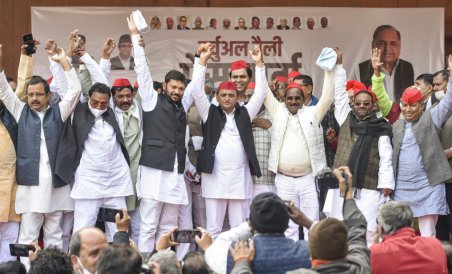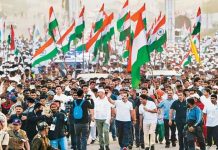By Chanakya
Third Wave of Coronavirus infections has hit India, and hit hard. Maybe the infections have been milder than the second wave, maybe the ICUs aren’t that full and maybe the requirement of oxygen has been low. But there have been spiralling deaths, hospitalisations and people still on edge. Schools and colleges have shut, business is again at a nadir and it will be an uphill task for the country, if immediate steps aren’t taken. Meanwhile, elections have been announced and the Gangasagar Mela has gone on unhindered. These two could become great super spreaders.
The big story has, of course, been the Omicron variant, an import from South Africa, but doctors have warned that the Delta variant is not dead yet, and Covid remains a dangerous disease for all practical purposes.
The arrival of the third wave was evident as early as on New Year’s Day. That was the day India reported 22,775 COVID-19 cases and 406 deaths. It was another matter that the recovery rate was at 98.32%, but on that day, for the first time, the number of daily cases had crossed the 20,000 mark since October. That was the day when 6,347 fresh cases were reported from Mumbai, 2,716 from Delhi, 2,398 from Kolkata, 810 from Bengaluru and 682 from Chennai.
That was the beginning. The day after New Year’s Day, India reported a 21 per cent jump in new cases there were 27,553 new infections that day. That was a period in which 284 people died due to Covid. The biggest surge happened in Delhi, with 2,716, a 50 per cent jump in coronavirus cases.
The positivity was at around 3.64 percent of all COVID-19 tests. By then, Maharashtra had reported 11,877 fresh COVID-19 cases, 2,707 more than the day before., of those there were 50 of the highly infectious Omicron cases. West Bengal was close on the heels, with 6,153 cases, 1,641 more than the previous day’s log.
Exponential growth
The almost exponential growth of Covid cases showed how fast this new variant moves. Soon, infections had spread to Uttar Pradesh, Rajasthan and then, almost inevitably, to the entire country. Government officials, the ICMR, ministers, including Prime Minister Narendra Modi, huddled in meetings, desperate to not let the second wave disaster repeat itself. So far, despite the incredible number of infections, there has been no need for lockdowns (some mini lockdowns have happened, though, as in Haryana), though several containment zones have been created.
The ICMR, the country’s premier control agency, has been issuing guidelines one after the other, and the country has been bracing for a disaster.


Business and commerce took the biggest hit, though, and unemployment rates rose as fast as infections. The government had too many things to worry about and education was another victim of this rise.
If, in the end, India does come out with flying colours from this third wave, with controlled deaths and dipping infections, then we will have to thank the success of India’s huge vaccination programme. India now has over a billion vaccinated people, and even 15 to 18-year-olds are getting vaccinated.
The new mutant
So, is the Omicron variant actually less virulent? Could be, but scientists remain worried about the unusually large number of mutations that Omicron (B.1.1.529) has. These mutations are in the part of its genome that encodes a key section of its spike protein, which the virus uses to infect host cells. This suggests that Omicron may be able to evade some of the immune protection afforded by vaccines, many of which are based on the original spike protein, and past infections.
According to a Harvard Medical School professor, who has been quoted in the media, possibly the milder infections are because the virus is coming in contact with mostly vaccinated people. That is a possibility, though the constant changes in nature of the virus keeps all medical people on tenterhooks. To this end, possibly, India’s vaccination rate has had its positive effect.
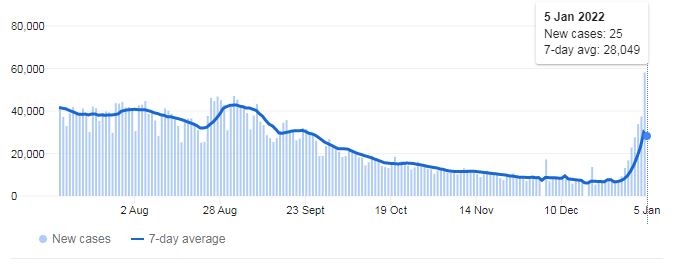

By January 3, according to the Union Ministry of Health, the Omicron tally in the country had reached 1,700, of which 639 had recovered or had been discharged.
Lower dearth rates
What was found was that deaths due to Omicron were far less and rare. While the spread was very fast, it causes “very mild disease like viral fever”. Maybe things are getting more serious for some, who have other co-morbidity issues.
The other important issue that came before the government was what to do with international flights. Finally, with the virus spreading fast across the globe, it was decided to keep international flights on hold, though the bubble services continued. Infections kept rising, however. Infections had spread to the south, from Karnataka, Odisha and Kerala, even the small state of Goa.
Another big problem was domestic travel. With winter at hand, people were not willing to have another holiday stuck at home and they moved. As they returned from their holidays, they brought back infections. There seemed to be no end to this and the country was reeling.
Meanwhile, no established manner of treatment was decided upon – not decided till the time of going to press – for Omicron. Old methods of treatment – these had been discarded even after the first wave and possibly midway the second wave – would not work, and even the use of paracetamol was advised to be used only if fever happens. The entire medical community seemed at a loss as to how to control the massive outbreak.
Amid this came the good news. It was said that possibly these multiple mutations were because the virus was trying to stay alive, and was trying to overcome the hurdles already posed by the vaccines and the antibodies in humans. So would this infection become endemic? That is the projection, though nobody is sure to which end this is going.
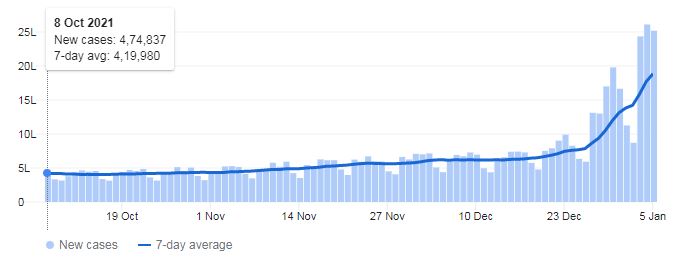

The political imbroglio
Politicians would not get back from their politicking, though. For example, of the 186 people who attended Bihar Chief Minister Nitish Kumar’s ‘janta durbar’ (people’s court) in Patna, six tested positive for Covid-19. As if that was not enough, former CM Jitan Ram Manjhi, his wife and 16 of his family members and staffers also tested positive. This was even as Bihar reported 1,074 fresh cases.
Security people had no option but to come in contact with people. They are the frontline workers. In Chhattisgarh, 38 jawans of CRPF camp at Temelwada, Chintagufa tested positive for COVID19 during antigen testing.
In Kolkata, entire police stations have tested positive. Quarantine procedures meant the police station remained virtually empty, other police stations sharing the responsibility of protecting that vacant zone. Same was the situation with Mumbai Police.
Delhi Chief Minister Arvind Kejriwal announced that he had tested positive for COVID-19 but had mild symptoms. He recovered quickly. The recovery time, thankfully, has come down to almost four days. There are people who are being admitted and instances getting worse, but the general trend has been that the virulence of Omicron might, finally, be less.
As said before, possibly the positivity rate was highest among healthcare workers, doctors and even policemen, who had the odious responsibility of keeping uncaring citizens in check. Hospitals were reporting a huge number of employees, nurses and even doctors down with Covid, way more than the last time around. This was scarier still, because had the Omicron variant become deadlier, then there would not even be the healthcare people around to take care of that.
Up to the northeast
The northeast states also came in contact with the infections soon enough. Covid cases started rising rapidly. In Assam, even as Chief Minister Himanta Biswa Sarma ruled out any lockdown, suggesting stricter measures to curb the spread, the Assam Health Department reported that the daily positivity rate rose from 0.77 percent to 2.37 per cent in just one week. Maybe that was an erroneous figure, because Covid-19 cases more than doubled in a single day to 2,198 in the state, highest tally in six months. Then came Manipur and Meghalaya.
By January 11 1,68,063 new Covid-19 cases had been reported and 277 related deaths. That took the country’s active count to 8,21,446. This is as per data from the Union Ministry of Health. The daily positivity rate had, by then, climbed to 10.64 per cent.
By then Delhi had ordered all private offices shut, asking employees to work from home, barring those in the exempted category such as private banks, pharmacies and courier services. This, left out in the cold (literally, with winter setting in and temperatures falling fast) daily wage workers, retailers etc, who had just about resumed jobs and reopened their shops after the second wave.
As expected, jails were not spared. This was a major issue during the second wave, when the Supreme Court had to move in, ordering a section of prisoners to be allowed special bail, to decongest the jails. Such orders have not been forthcoming in the third wave so far. By the second week of January 66 prisoners and 48 jail staff in Delhi jails had tested Covid-positive.
Infections at the top
The infection spread to top people. Defence Minister Rajnath Singh tested positive, BJP chief JP Nadda was positive, singer Lata Mangeshkar tested positive and was admitted to the ICU – still there as we go to press Karnataka CM Basavaraj Bommai tested positive, Bihar Chief Minister Nitish Kumar tested positive. The list seemed endless.
On January 13 the country reported 2,47,417 new cases. This was just a 24-hour figure. The positivity rate had risen to 13.11%, while the weekly positivity rate was recorded at 10.80 per cent. Remember, the recovery rate had come down to 95.59% from its earlier 98%-plus position. Things aren’t improving to such levels that might be considered comfortable.
Prime Minister Narendra Modi again interacted with chief ministers over the Covid situation, his second review meeting within a week. Earlier, Modi had called for ensuring adequate health infrastructure at the district level and for accelerating the vaccination drive for adolescents in mission mode.
By January 14, the positivity rate had gone up to 14.78%, with the weekly positivity rate rising to 11.83%.
The election mess
Meanwhile, the Election Commission of India (ECI) had announced elections to five states across India. Of those, Uttar Pradesh is to have a seven-phase affair. Elections start on February 10 and results are to be announced on March 10.
This could be another super-spreader. But that is the last of the concerns of the ECI. Even during the dangerous second phase, the ECI did not find it necessary to consider human lives important. With that dangerous disease phase, the ECI had announced an unprecedented eight-phase West Bengal elections.
This time, even with the extra fast spread of the virus, the ECI remains unfazed. Perhaps it is time for the top people at this organisation to understand that human lives are more important than an election process.
Good news from WHO
Meanwhile, the World Health Organisation (WHO) on January 5 observed more evidence that Omicron causes milder symptoms. It said that there was evidence emerging that the Omicron coronavirus variant was affecting the upper respiratory tract, causing milder symptoms than previous variants.
WHO Incident Manager Abdi Mahamud was reported as telling Geneva-based journalists: “We are seeing more and more studies pointing out that Omicron is infecting the upper part of the body. Unlike the other ones, that could cause severe pneumonia.” While he said this could be “good news”, he also added that Omicron’s high transmissibility means it will become dominant within weeks in many places, posing a threat in countries where a high portion of the population remains unvaccinated.
On January 8 WHO chief Tedros Adhanom Ghebreyesus said that record numbers of people are being infected by the new variant which is rapidly out-competing the previously-dominant Delta variant in many countries. Tjhis also meant, he added, that hospitals were being overwhelmed. He added a warning, saying that while Omicron does appear to be less severe compared to Delta, especially in those vaccinated, it does not mean it should be categorised as mild. “Just like previous variants, Omicron is hospitalising people and it is killing people,” he explained.
Covid norms must stay
In India too, Dr Samiran Panda, a top epidemiologist at the Indian Council of Medical Research (ICMR) said he expects the Covid curve could begin to flatten within three months. However, he said that the coronavirus graph case could flatten only if people follow Covid norms.
He was quoted in the media as saying: “The Covid curve could flatten in the next three months, provided these four things happen. Those states that fall behind in vaccination try to ramp it up, people avoid mass gatherings, people avoid non-essential travel and maintain mask usage with vaccination.”
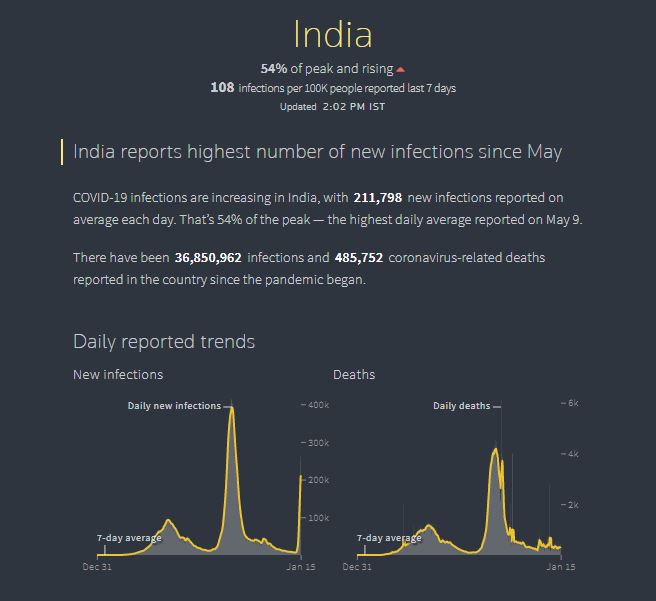

Said Union health minister Mansukh Mandaviya: “We are continuously reviewing the existing health infrastructure and preparedness in all states in the country.”
The ills of pills
Dr NK Arora, Chairman of Covid-19 Working Group of NTAGI, has said that Molnupiravir, an antiviral Covid-19 pill, should not be given to people of the reproductive age. He added that the drug can be given to senior citizens, particularly those with comorbidities, to reduce the chance of hospitalisation and severe illness. He also stated that irrational use of the pill can be dangerous.
It has been repeatedly said that Omicron is not common cold and it is a misconception that is spreading. This warning, from the government’s top Covid adviser VK Paul, was essential, because that was what the people had started thinking. Treating this infection as a common cold was the last thing that should be done. Less virulent or not, Omicron, too should be treated with care and all Covid norms are essential.
What we need to remember is that maybe they are less in number than the last time, but deaths are happening. People are being moved to ICUs, there have been a huge number of hospitalisations. In the end, it is our careful living that will be the key. Possibly, we will have to live with Covid for the rest of our lives, as this becomes endemic. But we still treat malaria as a dreaded disease, as we do dengue and other infections. Most importantly, scientists are still pretty much in the dark as to details of the virus. We will have to wait for the full picture to emerge. Until then, caution is the key word.
WB State Election Commission defers civic polls
Following a stern probe from the Calcutta High Court, the West Bengal State Election Commission (WBSEC) developed cold feet and announced that the municipal elections in Asansol, Bidhannagar, Siliguri and Chandannagar, which were slated to be held on January 22, were being postponed to February 12.
The state election commission, which has been completely immune to human tragedy and the dangers of Covid in the past, now suddenly realised its folly and said that it was doing so, taking into consideration the Covid-19 situation.
A day before the announcement by the state commission, the Calcutta High Court had ordered it to explore the possibility of deferring the polls by four to six weeks in view of a high number of Covid cases. State government sources had said that they had also requested WBSEC to defer the polls in view of the Covid-19 crisis.
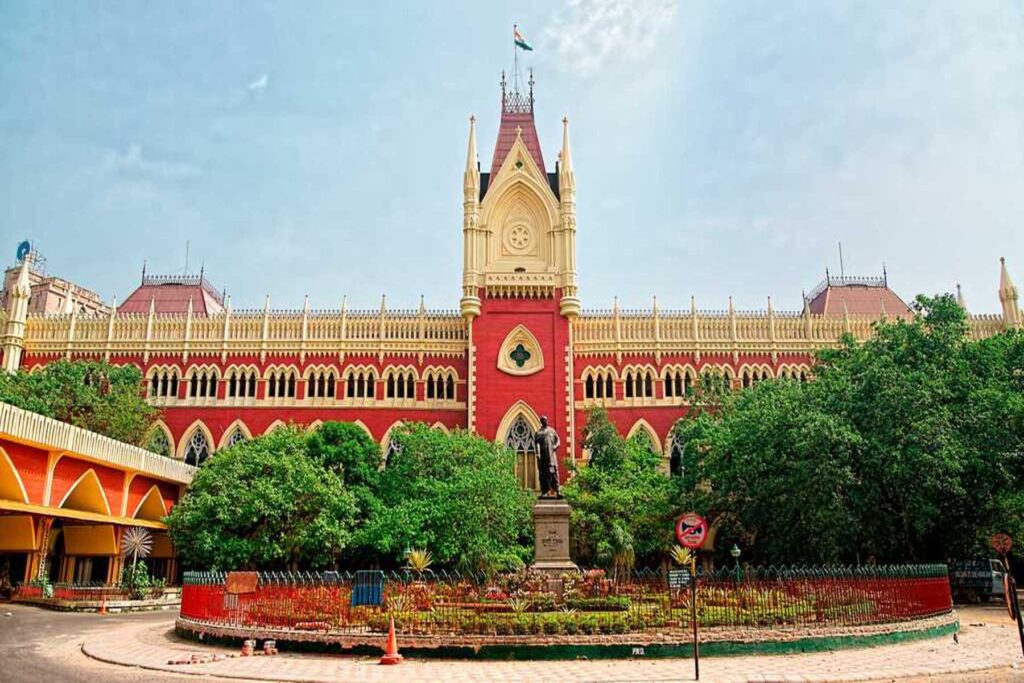

The notification issued by WBSEC stated: “In compliance with the solemn Order dated 13.01 .2022 of the Hon’ble Division Bench, High Court Calcutta, in the matter WPA(P) No. 4 of 2022 Bimal Bhattacharya vs State of West Bengal and others, the West Bengal State Election Commission, on consideration of the prevalent COVID19 pandemic situation, in exercise of the power conferred by Section 8 of the West Bengal State Election Commission Act, 1994 read with Section 84 of the West Bengal Municipal Elections Act, 1994, in modification of its earlier notification No. 1347-SEC/LE-9912021 dated 28.12.2021 in respect of the Municipal Corporations mentioned in the schedule below, hereby appoints the 12th day of February, 2022, as the date on which the poll shall be taken from 07.00 AM to 05.00 PM, without interruption.”
During the last assembly elections in the state, when Covid was raging across India, the Election Commission of India had scheduled an unprecedented 8-stage election in West Bengal. Pleas to change were paid heed to by the ECI, neither by the state commission. The sheer hubris of the ECI was, obviously, with political backing and the idea of a neutral election commission was thrown out of the window.
When the Calcutta High Court sent an order, the election commissioner was scared out of his wits, it seems.
Virtual rally
A case was registered on Friday after a massive 2500 crowd in Lucknow , in violation of Covid norms, gathered at the Samajwadi Party office here for the joining-in function of two rebel ministers and some MLAs. The FIR was registered according to the directives of the Election Commission on Covid-related norms, officials said. Election Commission suspends SHO after row over political gathering of Samajwadi Party. Police Commissioner (Lucknow) D K Thakur confirmed that the station officer was suspended.
